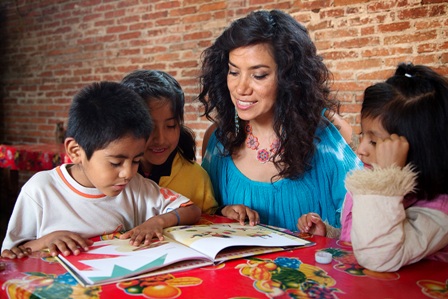
On Creativity and Culture: Yuyi Morales
To celebrate Hispanic Heritage Month, we had the opportunity to talk with the award-winning author and illustrator Yuyi Morales about why she became an author and illustrator, the role of children’s books in understanding and celebrating cultures and her new book, “Viva Frida.” Click here to read this blog in Spanish.
What led you to become a children’s book author and illustrator?
Soon after I immigrated to the USA in 1994, I found myself with my newborn at the doorsteps of the public library. I had never before seen a place with the treasures I saw in there. Picture books immediately became my passion.
I didn’t know how, but I knew I wanted to create books like those. I started a journey of learning how to write in English, how to create stories, and how paint and make illustrations – a journey I am still on every day of my life.
In what ways does your personal story and your cultural heritage influence the work that you do?
I was inspired to write my stories and share with my son, then a baby who immigrated with me from Mexico. The only way of living I knew until then were the stories, the customs, the treasures of the land we came from. Learning to live and thrive in the United States reflected in everything I did, including my writing and the art I was trying to learn to create.
My creations became the amalgam of these two worlds: my country of birth and my country of growth and work, my past and my present, the cultures that formed me, both Mexico and the United States.
What impact do you see children’s books having in the lives of children and their families, particularly first generation immigrant families?
I can tell you about my own experience as a first generation immigrant because children’s books made all the difference in my life. It was through children’s books that my son and I created a bond – finding, reading, and delighting in books that I was barely able to understand and that were a great challenge for me to read to my son. In reading to him, I began making sense of the English language and I was able find a purpose and path. Through children’s books, I was also able to create a bond with my new country – the USA.
I believe there are many families who share my experience. Books bring families and communities together. Any family can find a way to grow and strengthen bonds by sharing the experience of books with their children.
What motivated you to tell Frida’s story from her own point of view, and in so few words?
One of the things that surprised me here in the USA was seeing how Frida was such a revered artist. Back in Mexico I had seen very little of her and what I knew of her – her art – was very confusing and sometimes even scary to me. But over the years I became more and more curious about Frida.
I began to learn about her determination to create despite her physical and emotional hardships. I began to connect with the tragedies in her life as well as her great willingness to live, to create, to play, to laugh.
She became to me a symbol of resistance, of growth, of creativity and of life endurance. I wanted to celebrate Frida by honoring her passion to create and to heal herself through art. I wanted to celebrate that, like Frida, we all have what it takes to create.
Your use of both two- and three-dimensional art in the book is truly extraordinary. How did you settle on this style, and did it pose any unique challenges?
To me Frida represents creativity and daring to create things out of the ordinary. I wanted to make the book I dreamed of without being scared of whether I was capable of doing it. So I dreamed big! I thought I could make a book that conveyed how Frida made her own life and identity a work of art.
The combination of two- and three-dimensional art grew from my desire to weave together everyday life and imagination.
For other books and resources of interest, visit the First Book Marketplace.
